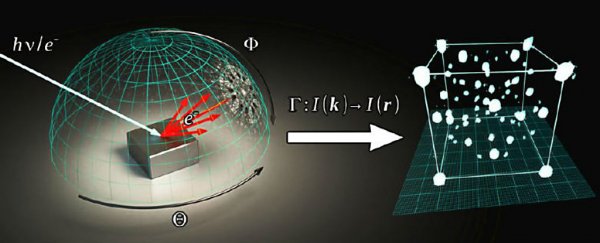In the same way that Microsoft's HoloLens device could one day see you walking around a 3D projection of Minecraft in your living room, scientists have developed new holographic technology that allows them to 'peer' inside a molecule to figure out the exact arrangement of atoms inside.
This is the first time that anyone has been able to clearly see inside molecular structures with this degree of accuracy, and it's hoped that the technology will lead to a better understanding of the unique properties of different kinds of molecules, whether in biological systems, or crazy new materials.
As Lisa Zyga from Phys.org explains, scientists have struggled to see inside small molecules ever since we knew they existed, with the best and most reliable imaging techniques limited to scanning their surfaces. For anything more, indirect investigation methods or theoretical predictions had to be made.
It's expected that the new system, developed by physicist Tobias Lühr from the Technical University of Dortmund in Germany and his team, will offer far more accuracy.
As Kate Baggaley from Popular Science explains, the new method works by shooting high-energy electrons at the molecule under investigation. The electrons scatter as they hit the molecule, bouncing off in distinct patterns based on the layout of individual atoms, and through these patterns, researchers are able to build up a hologram of the whole molecule.
This not the first time holographic technology has been used to image molecular structures, but the new method reduces the marks and imperfections that previous techniques left on the resulting images, and can distinguish between different types of atoms.
And unlike previous technologies, the new technique can also handle more than 10 atoms at a time - a rather serious limitation that's held back the research up to this point.
Key to the improvements in the technology is the use of more energy behind the electron waves, to the tune of several thousand volts. This in turn leads to clearer pictures, because the waves can be more easily constrained and don't spread out as much. Pyrite - aka Fool's Gold, or FeS2 - was used as the test substance.
"In order to understand the physical and chemical properties of advanced materials, functional molecular adsorbates, and protein structures, a detailed knowledge of the atomic arrangement is essential," writes the team in the journal Nano Letters. "We present a general reconstruction algorithm that leads to high-quality atomic images showing thousands of atoms."
The next step is to figure out all of the ways the new holographic technology can be used in further research - and there are likely to be a lot of them. If there's one thing we don't know nearly enough about, it's the tiny building blocks that make up every single thing we see around us. We'd better get on that.
